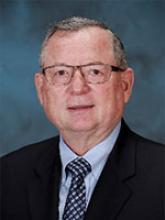Functional Nanostructures in Ceramics using Ion Beams
Date & Time:
Fri, 10/20/2017 - 2:00pmSpeaker:
William J. WeberAffiliation:
University of Tennessee, KnoxvilleLocation:
Discovery Park B155
Abstract:
Interactions of energetic ions with solids results in inelastic energy loss to electrons and elastic energy loss to atomic nuclei. The coupled effects of these energy loss pathways on defect production, nanostructure evolution and phase transformation in ceramics are complex and not well understood. Using experimental and computational approaches, we have investigated the separate and combined effects of nuclear and electronic energy loss on the response of ceramics to ion irradiation over a range of energies. Experimentally, ion mass and energy are used to control the amount of energy deposition and the ratio of electronic to nuclear energy loss. Large scale molecular dynamics simulations, which include ballistic collision processes and inelastic thermal spikes, are used to model these effects. We have demonstrated: 1) additive effects of nuclear and electronic energy loss on damage production; 2) competitive effects via ionization-induced dynamic recovery; and 3) synergistic effects between pre-existing defects and electronic energy loss on damage production. The present study focuses on the coupled effects of nuclear and electronic energy loss on the formation of functional nanostructures in ceramic oxides. This work advances the understanding on the role of defects in electronic energy dissipation and electron-phonon coupling. The knowledge gained provides insights for creating novel interfaces and nanostructures with controlled morphologies, multiple phases and local strain, which can be employed to engineer functionalized thin film structures with tunable electronic, ionic, magnetic and optical properties on the nanoscale. These results also have significant implications for the response of materials to extreme radiation environments, dynamics of ion-irradiation effects, and modification of materials using ion beams.This work was supported by the U.S. Department of Energy, Office of Basic Energy Sciences, Materials Sciences and Engineering Division.

Biography:
Prof. William J. Weber is the Governor's Chair Professor for Radiation Effects on Materials in the Department of Materials Science and Engineering at the University of Tennessee, with a joint appointment at Oak Ridge National Laboratory. He also serves as Director of the Ion Beam Materials Laboratory at the University of Tennessee. He received a BS degree in Physics from the University of Wisconsin, Oshkosh, and MS and PhD degrees in Nuclear Engineering from the University of Wisconsin, Madison. He joined Pacific Northwest National Laboratory (PNNL) in 1977, was appointed Laboratory Fellow in 1997 and served as Chair of the Council of Fellows from 2005 to 2009. In 2010, he joined the faculty at the University of Tennessee. Dr. Weber is an internationally recognized leader and expert on radiation effects and ion beam modification of ceramics. Much of his current research is focused on the coupling of electronic and ionic energy dissipation processes in ceramics, and their role on evolution of defects, nanostructures and novel functionalities. His scientific impact is well represented by his publication and citation record. He has published over 500 journal articles with over 14,100 citations and an h-index = 58. Google Scholar: over 19,250 citations; h-index =68. He is a Member of the European Academy of Sciences (2016) and a Fellow of the American Ceramic Society (2000), the American Association for the Advancement of Science (2006), the Materials Research Society (2008), the American Physical Society (2010), and the Ion Beam Society of India (2016). He is the recipient of the Lee Hsun Lecture Award (IMR, Chinese Academy of Sciences); Outstanding Young Alumni Award and Distinguished Alumni Award (University of Wisconsin-Oshkosh); the U. S. Department of Energy's Materials Science Award for Research with Significant Implication for DOE Related Technologies; the PNNL Laboratory Director's Award for Individual Lifetime Achievement in Science & Technology; the PNNL Director's Award for Scientific and Engineering Excellence; and the PNNL Chester L. Cooper Mentor of the Year Award. In 2001, his work on developing radiation-resistant ceramics was recognized by the U.S. Department of Energy's Office of Science - Decades of Discovery as one of the top 101 innovations during the previous 25 years. He has chaired over 30 international conferences, society symposia, and topical workshops. He currently serves as a principal editor for the Journal of Materials Research.
Department:
Materials Science and Engineering